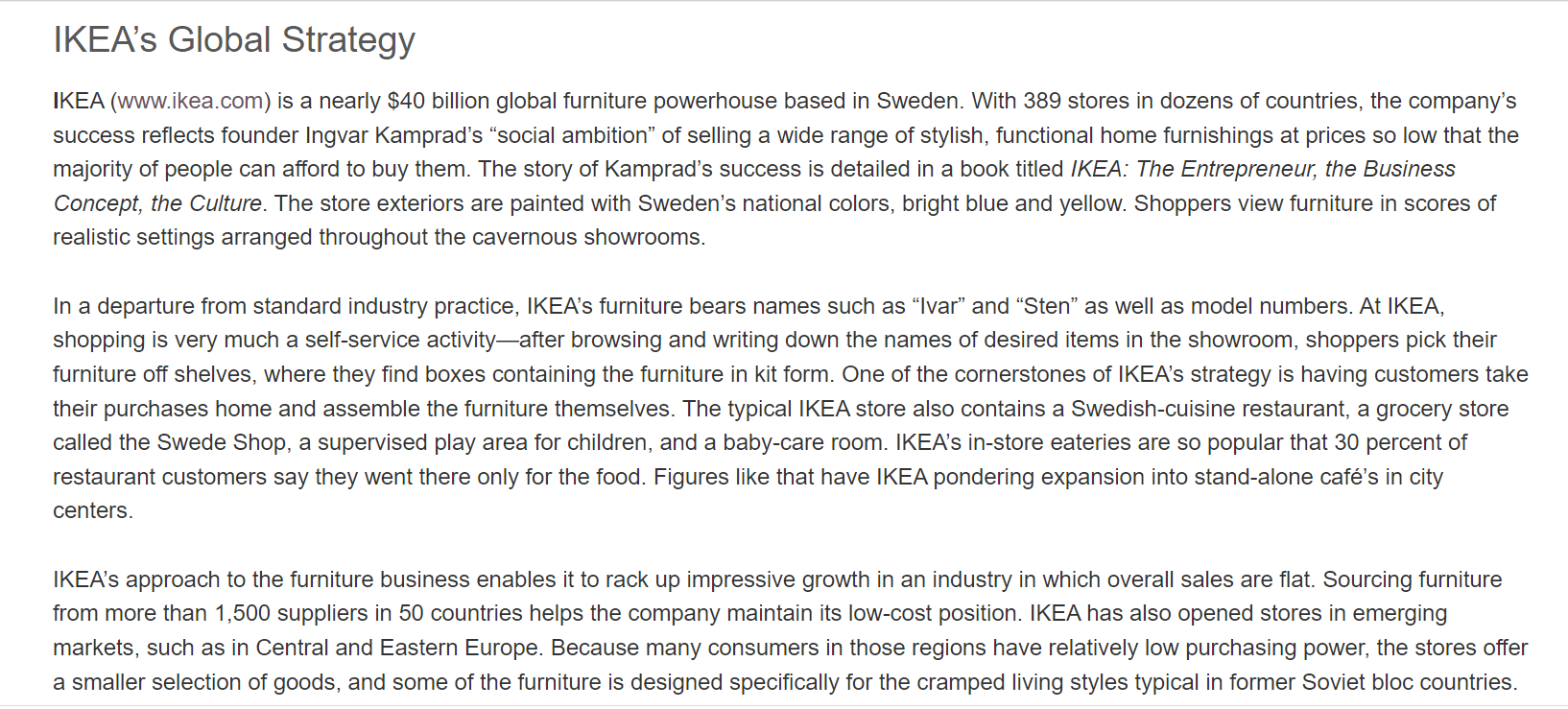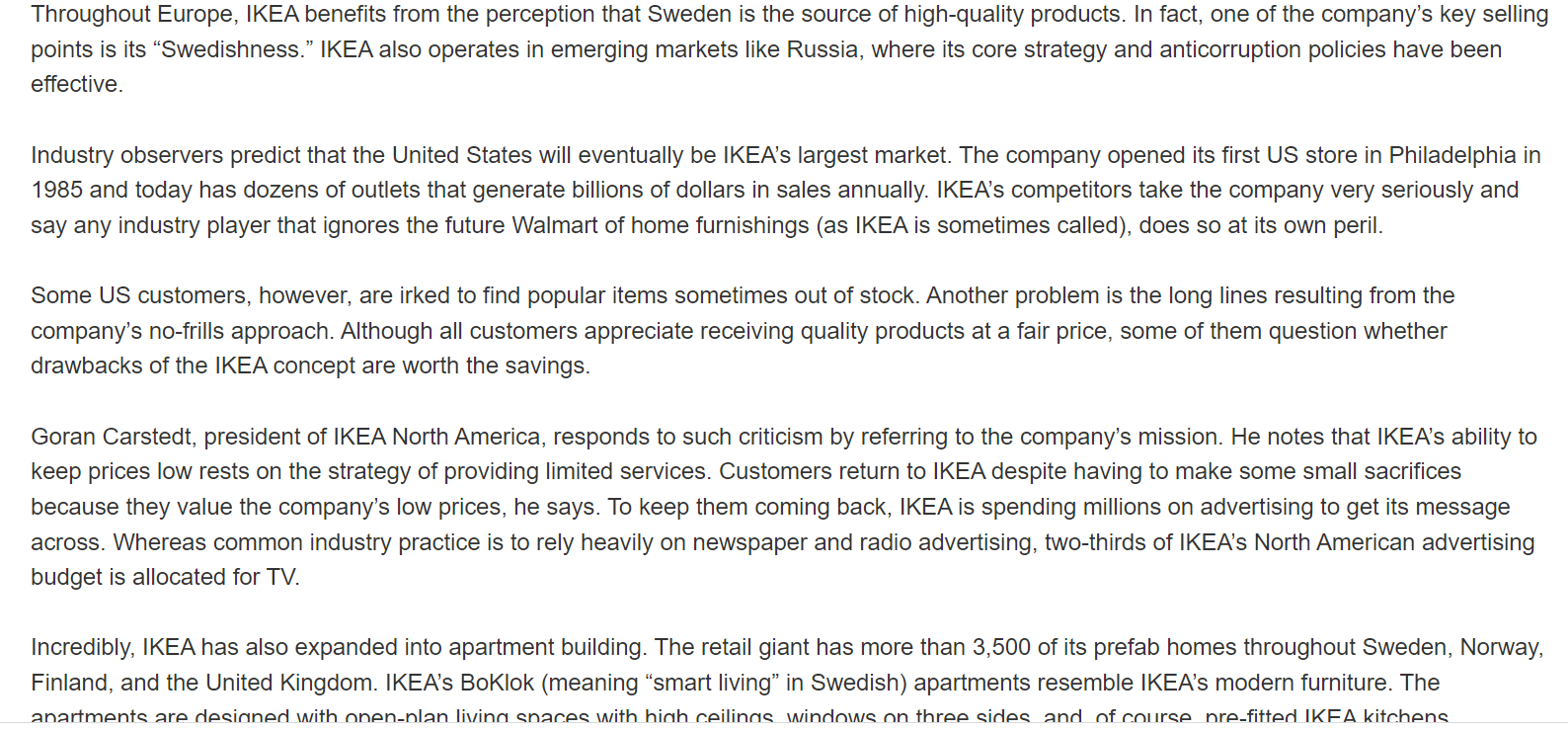


IKEA (www.ikea.com) is a nearly $40 billion global furniture powerhouse based in Sweden. With 389 stores in dozens of countries, the company's success reflects founder Ingvar Kamprad's "social ambition" of selling a wide range of stylish, functional home furnishings at prices so low that the majority of people can afford to buy them. The story of Kamprad's success is detailed in a book titled IKEA: The Entrepreneur, the Business Concept, the Culture. The store exteriors are painted with Sweden's national colors, bright blue and yellow. Shoppers view furniture in scores of realistic settings arranged throughout the cavernous showrooms. In a departure from standard industry practice, IKEA's furniture bears names such as "Ivar" and "Sten" as well as model numbers. At IKEA, shopping is very much a self-service activity_after browsing and writing down the names of desired items in the showroom, shoppers pick their furniture off shelves, where they find boxes containing the furniture in kit form. One of the cornerstones of IKEA's strategy is having customers take their purchases home and assemble the furniture themselves. The typical IKEA store also contains a Swedish-cuisine restaurant, a grocery store called the Swede Shop, a supervised play area for children, and a baby-care room. IKEA's in-store eateries are so popular that 30 percent of restaurant customers say they went there only for the food. Figures like that have IKEA pondering expansion into stand-alone caf's in city centers. IKEA's approach to the furniture business enables it to rack up impressive growth in an industry in which overall sales are flat. Sourcing furniture from more than 1,500 suppliers in 50 countries helps the company maintain its low-cost position. IKEA has also opened stores in emerging markets, such as in Central and Eastern Europe. Because many consumers in those regions have relatively low purchasing power, the stores offer a smaller selection of goods, and some of the furniture is designed specifically for the cramped living styles typical in former Soviet bloc countries. Throughout Europe, IKEA benefits from the perception that Sweden is the source of high-quality products. In fact, one of the company's key selling points is its "Swedishness." IKEA also operates in emerging markets like Russia, where its core strategy and anticorruption policies have been effective. Industry observers predict that the United States will eventually be IKEA's largest market. The company opened its first US store in Philadelphia in 1985 and today has dozens of outlets that generate billions of dollars in sales annually. IKEA's competitors take the company very seriously and say any industry player that ignores the future Walmart of home furnishings (as IKEA is sometimes called), does so at its own peril. Some US customers, however, are irked to find popular items sometimes out of stock. Another problem is the long lines resulting from the company's no-frills approach. Although all customers appreciate receiving quality products at a fair price, some of them question whether drawbacks of the IKEA concept are worth the savings. Goran Carstedt, president of IKEA North America, responds to such criticism by referring to the company's mission. He notes that IKEA's ability to keep prices low rests on the strategy of providing limited services. Customers return to IKEA despite having to make some small sacrifices because they value the company's low prices, he says. To keep them coming back, IKEA is spending millions on advertising to get its message across. Whereas common industry practice is to rely heavily on newspaper and radio advertising, two-thirds of IKEA's North American advertising budget is allocated for TV. Incredibly, IKEA has also expanded into apartment building. The retail giant has more than 3,500 of its prefab homes throughout Sweden, Norway, Finland, and the United Kingdom. IKEA's BoKlok (meaning "smart living" in Swedish) apartments resemble IKEA's modern furniture. The anartmente are decioned with nnen-nlan living enaces with hiah ceilince windowe nn three sides and of cource nre-fitted IKFA kitchene company's no-frills approach. Although all customers appreciate receiving quality products at a fair price, some of them question whether drawbacks of the IKEA concept are worth the savings. Goran Carstedt, president of IKEA North America, responds to such criticism by referring to the company's mission. He notes that IKEA's ability to keep prices low rests on the strategy of providing limited services. Customers return to IKEA despite having to make some small sacrifices because they value the company's low prices, he says. To keep them coming back, IKEA is spending millions on advertising to get its message across. Whereas common industry practice is to rely heavily on newspaper and radio advertising, two-thirds of IKEA's North American advertising budget is allocated for TV. Incredibly, IKEA has also expanded into apartment building. The retail giant has more than 3,500 of its prefab homes throughout Sweden, Norway, Finland, and the United Kingdom. IKEA's BoKlok (meaning "smart living" in Swedish) apartments resemble IKEA's modern furniture. The apartments are designed with open-plan living spaces with high ceilings, windows on three sides, and, of course, pre-fitted IKEA kitchens. Thinking Globally 11-9. When company founder Kamprad decided to expand into China, he based his decision on his own intuition, not on market research. Looking at IKEA's current performance in China, did Kamprad's decision pay off? 11-10. Relying on topics covered in this chapter, would you classify IKEA's approach as one of standardization or adaptation in markets around the world? Explain









